Video-on-demand Application: Cost and Features
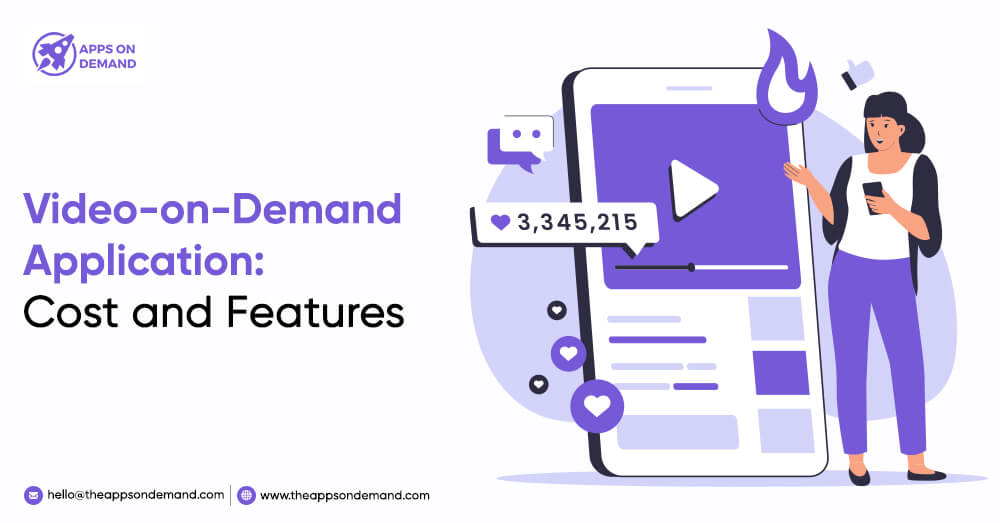
Quick Summary :
Video-on-demand (VOD) applications provide unmatched flexibility and customization in how we consume and experience video content. New businesses looking to create their own video-on-demand apps need to know the top features and costs of these apps to develop competitive and profitable VOD apps.
Among various types of content, video content is the one that will never stop fascinating people. The projection or video delivery method might have evolved from live theatres to cables and surfing on personal devices. But the way it keeps viewers engaged hasn’t changed a bit. However, people have developed a desire to view content that matches their interests. They don’t want to wait for a certain time to watch it. Instead, they prefer streaming anytime anywhere, and take pause whenever needed.
Thus, it led to Video On Demand App Development, which provides many more facilities for viewing videos as and when required. These apps have features that allow users to view their favorite shows or stream the required video content via their mobile phones, laptops, and tablets.
However, the more convenience and features users expect, the more technically challenging it becomes for content distributors to provide an optimal level of hassle-free experience. Content distributors and streaming services need quality apps to provide their users with exceptional viewing and content consumption experience. However, they don’t need to do it from the first step. They can seek help from quality on-demand video app developers such as AppsOnDemand.
In this article, we shall walk through a comprehensive overview of the Video on Demand app, its types features, and the development process.
What is a Video-on-Demand App?
Video on Demand app is a content distribution system powering the streaming of diverse video content to users. The content can be either pre-recorded content like movies, video songs, series, or tutorials that belong to another party or are originally produced by the streaming company itself (for example Amazon Originals, Netflix Originals).
It can be accessed on various types of devices as long as it has a strong internet connection. In simple words, if there was a release of a movie and you couldn’t go to theatres, there is a possibility your Video on demand app will get the license to post on its web app, hence giving you the accessibility to streaming it easily.
It has become quite popular among today’s generation over the last decade. Statistics don’t lie and have shown that with the projections of 9.71% CAGR (the year 2023-2027), the video streaming app industry is expected to reach $230.90 billion by 2027.
This means now is the right time to invest in video-on-demand development as the need for it among users will only increase in the coming years.
Types of Video-on-Demand Apps
There are various types of Video streaming applications. Some of them are mentioned below
A. Over-the-Top (OTT) Platforms
These deliver video content over the Internet rather than traditional cable or satellite TV. These provide users access to a vast library of movies, TV shows, and exclusive content on demand. Most OTT services offer subscription-based models, transactional models, and ad-supported models. Examples: Amazon Prime.
B. On-Demand Video-Streaming Platforms
Such platforms allow the streaming of content from the library. Users can also upload their content. It usually has interactive features such as comments and likes. Monetization option for content creators through ads, and paid subscriptions. Examples include Dailymotion.
C. On-Demand Live Streaming Apps
In this, the live videos are broadcasted and users can experience real-time streaming of concerts, gaming sessions, and sports etc on online platforms. It requires multi-camera support for professional live streaming. Examples may include sports streaming on Hotstar.
D. On-demand Social Media Streaming Apps
This is available on social media itself where users can access live or recorded videos. It may include short or long video forms. There are algorithm-driven content recommendations. Examples are Instagram reels and TikTok.
E. On-demand Music Streaming Apps
Through music streaming apps, users can view music videos. Some also give personalized recommendations based on listening history, offline playback, and playlist creation. Examples include Spotify and Apple Music.
F. On-Demand Educational Streaming Apps
Platforms that give access to video courses, tutorials, interactive courses, and lectures on various subjects come under this category. Some even provide certificates upon course completion. For example IBM Cloud Video, Discovery+, etc.
From OTT to educational streaming Apps! We have got you covered! Develop a custom video-on-demand app for your business that stands out!
Key Features of Video-on-Demand App: User Features, Admin Features, Advanced Features
The video-on-demand app offers multiple features to users for seamless streaming and to admins as well as for developing desirable content distribution across the platform.
#User Features
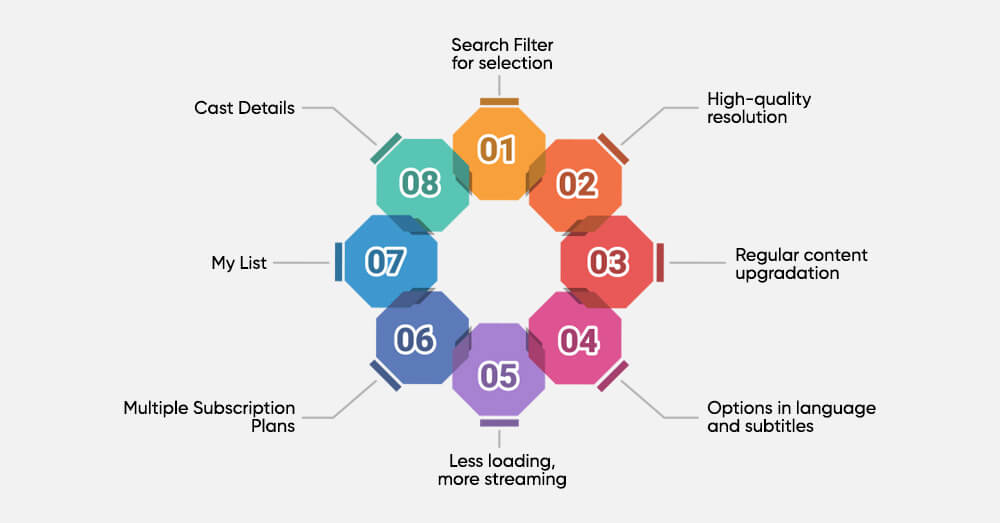
First let’s discuss what VOD features users get:
Search Filter for selection
Usually, all types of on-demand video streaming apps have a search bar where you can look for content with its name, and suggestions appear accordingly. Various OTT platforms like Netflix and Amazon give recommendations based on the genre for users to browse according to their preferences.
High-quality resolution
Every user wants to view high-definition quality, so it is a feature made available on the custom on-demand video app. However, if the user data connection isn’t strong enough to support high-quality streaming, it can switch to a lower resolution like 144P.
Regular content upgradation
Video-on-demand streaming apps keep up with regular trends and the popular demand of target users and post new content almost every day. They fulfill their promise by providing easy access to content, ensuring you don’t have to struggle to find it anywhere else.
Options in language and subtitles
The operators of video-on-demand app platforms understand that users would prefer content in a language that matches their understanding. Therefore wide range of audio and subtitle language is included in most of the content.
Less loading, more streaming
If content takes a lot of time to load and stops in between, it won’t create the uninterrupted experience that a user expects. Thus the best video-on-demand streaming platforms ensure fast page loading and switching between content to content.
Multiple Subscription Plans
By offering multiple payment option plans based on duration, devices allowed, quality, etc, users can choose their preference and switch according to their future streaming schedule.
My List
Most video-on-demand apps allow users to add their favorite shows and movies to the viewing list. Users can watch these shows later but add them before to the list for easy remembrance.
Cast Details
OTT Apps generally have this feature in which the details of the on-screen cast is visible on the left or right bar of the app.
#Admin Features
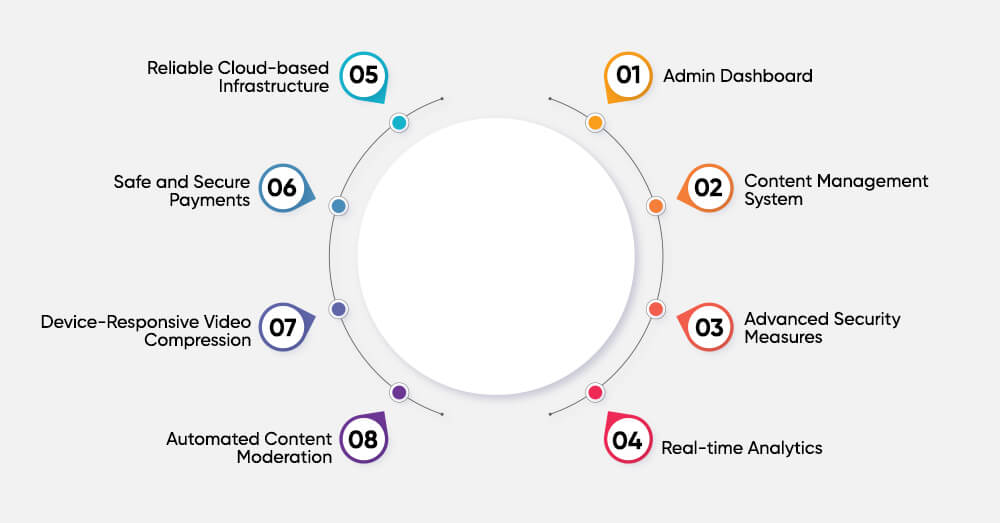
Now let’s discuss a few features admins get if they invest in the right on-demand video development services.
Admin Dashboard
Provide content creators with detailed insights into their content performance, including view counts, engagement metrics, and revenue generation.
Content Management System
The Video streaming app has an efficient CMS that allows seamless video upload, metadata management, organization of content into different categories, version controls, and backups. It offers tools to upload subtitles, captions, and audio tracks. There are automated processes like transcoding and streamlining operations.
Advanced Security Measures
Advanced security integrations like platform-specific DRM, and HLS encryption, are implemented to avoid data breaches and third-party attacks. Security measures like SSL certificates can be incorporated to improve data sharing between servers and clients. Additionally, compilation with security laws like HIPAA and GDPR can strengthen the authenticity
Real-time Analytics
At the admin’s end, the on-demand streaming app allows decoding of the content performance and analysis of viewer behavior through their streaming choices. This helps in recognizing improvement requirements and optimizing content to be broadcast accordingly.
Reliable Cloud-based Infrastructure
The VOD app has cloud-based data storage systems for efficient storage, streaming, and content management. This also improves security and makes it easy to upgrade new features.
Safe and Secure Payments
In a day, multiple people subscribe to VOD apps and make payments for them. The Video-on-demand development is done in such a way that it procures secure transactions from the user’s end till it reaches the recipient.
Device-Responsive Video Compression
The interface of the website and streaming videos is designed to suit various types of devices, used by viewers. The media’s size and quality get compressed according to the device used for on-demand streaming. For example, you must have observed various VOD apps appear differently when you use a laptop versus when you are streaming on a mobile phone.
Automated Content Moderation
Implement AI-driven content moderation tools to flag and review potentially inappropriate or copyright-infringing content.
#Advanced Features
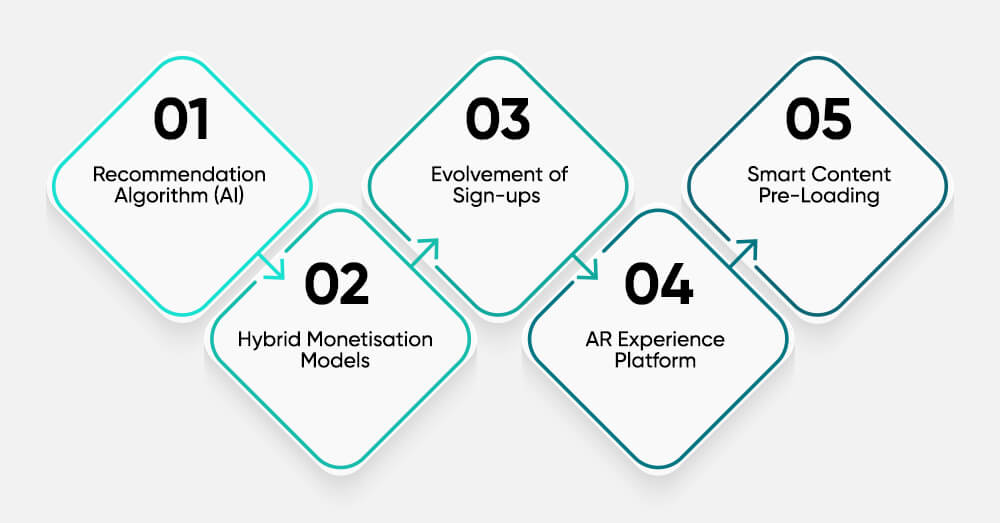
Advanced features can boost user experience to a more high level. These are:
Recommendation Algorithm (AI)
Using Artificial intelligence, a customized experience for users is created. This includes collection and analysis of user watch history, reviews, search history, and time spent on type of content using ML algorithm. This is followed by suggestions of similar or relevant content that the user hasn’t watched yet.
Hybrid Monetisation Models
Blending various types of monetization models might give users the chance to choose their convenient way of subscribing at the same VOD. For example, Amazon has included a Subscription-Based Model (SVOD), Transactional Video on Demand (TVOD), and Ad-Supported Video on Demand (AVOD), creating diversified options for users.
Evolvement of Sign-ups
As an upgrade to the general sign-up process which requires creating a new account, some VOD platforms do or can offer sign-up using other social accounts. This makes the process more convenient and faster. Moreover, collaborative on-demand streaming that allows different people to watch content at the same time can be expected.
AR Experience Platform
Add augmented reality capabilities to engage with content uniquely, including exclusive footage, interactive promotional materials, or enhanced content previews.
Smart Content Pre-Loading
Employ artificial intelligence to anticipate and buffer content based on user viewing patterns, minimizing load times and enhancing streaming quality.
What is the Cost of Video On Demand App Development?
The video-on-demand app development cost cannot be pinned down to a fixed amount. It varies from service to service and also on the specific requirements of the clients. The main contributing factors include complexity, required features in the app, tools, security system, and so on.
The video-on-demand app development services also create various pricing plans that would suit the requirements of the client. The average pricing is between $50,000 – $5,00,000.The more customized and advanced interface is required, more effort and use of expensive software will be procured, hence the price will also vary.
App Complexity Level | Cost Range | Development Time | Use Case |
Basic VOD App | $15000-$25000 | 1-2 Months | Small content creators |
Medium Complexity | $25,000 – $50,000 | 3-4 Months | Growing media companies |
Advanced/Enterprise | $50,000 – $250,000 | 5-7 months | Large media corporations |
Premium/Custom | $250000- $500000+ | 8-10+ months | Major media networks |
Monetization Models for Video-on-demand Apps
Video-on-demand (VOD) platforms have several monetization strategies to generate revenue from their content. The primary methods include:
1. Subscription Video on Demand (SVOD)
In this type, users have to pay fees either on a monthly or yearly basis. During this period users can access the content library and have to pay again once their plan expires. This model offers boundless viewing during the subscription. Examples include Netflix and Disney Hotstar.
2. Transactional Video on Demand (TVOD)
Through this monetization method, viewers can purchase or rent individual pieces of content. Usually, this model is suited for exclusive or newly released content. Examples of platforms that employ this approach include iTunes and Google Play
3. Advertising Video on Demand (AVOD)
This type of monetization allows free streaming. However, users may be interrupted by advertisements during the playback. Such VOD developments generate revenue through placements of advertisements before or between the videos. Examples may include YouTube and Tubi.
Process of Video-on-Demand App Development
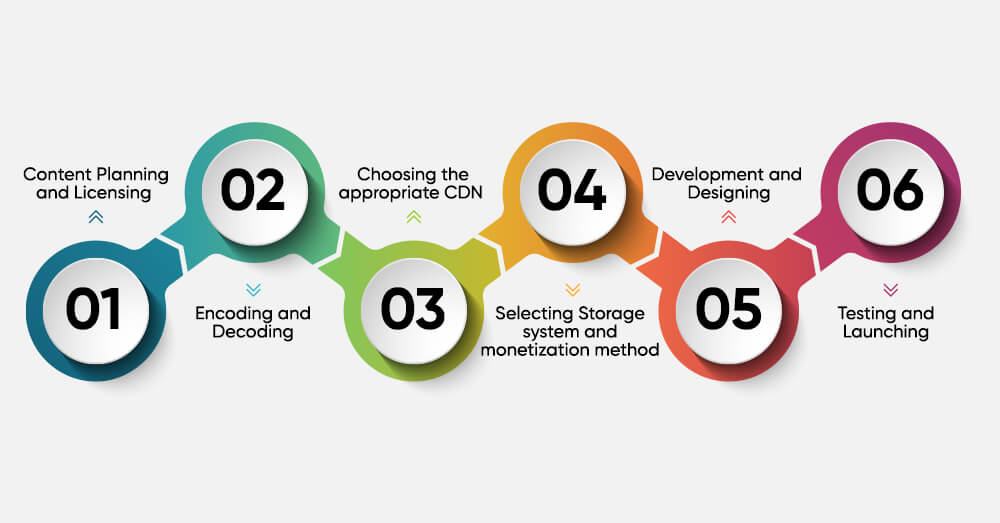
Browsing through a VOD application feels like a piece of cake. However, it takes immense effort to create such a user-friendly application. The complete Video on Demand app Development process includes planning, designing, developing, testing, and launching. Let’s discuss them in detail :
1. Content Planning and Licensing
First, determine who your target users are and what type of content they would prefer to stream. Start collecting unique content or get a license to stream non-original content from content providers.
2. Encoding and Decoding
Convert video files into multiple formats and resolutions for compatibility. Use adaptive bitrate streaming (ABR) to adjust video quality based on internet speed.
3. Choosing the appropriate CDN
The CDN is a geographical distribution of servers that speeds the delivery of content. It saves copies of the original content present on your VOD. When the user from any location streams, it chooses the nearest service that allows fast playbacks. Choose a CDN based on your primary geographic focus.
4. Selecting Storage system and monetization method
Choose the key VOD platform features you want to include in your VOD app, For example, real-time analytics, cloud storage, and monetization methods. Using CMS organize and distribute content across the platform.
5. Development and Designing
Creating a VOD application consists of deciding its appearance and coding to secure the functionality of the website. The technologies include PHP, MySQL for the backend, and HTML, and Javascript for the front end.
6. Testing and Launching
Perform extensive testing to ensure smooth performance on different devices. Test for buffering issues, video quality, security vulnerabilities, and user experience (UX/UI).
Want a feature-rich VOD app that is easy to monetize?
Popular Approaches to Develop VOD Platforms
To develop a VOD platform three types of approaches are preferred:
Agile Methodology
The Aglile VOD app development lifecycle includes collaboration ( developers, designing, and stakeholders), continuous interaction(regular assessment and adaption), and improvement based on customer feedback.
Bespoke App Development
This video-on-demand app development process focuses on providing customized solutions to meet business requirements by integrating unique features, platform design, and functionalities. This is useful in reflecting a company’s ideas and goals to users.
Cloud-Based Infrastructure in VOD
Using cloud-based video streaming can improve scalability and enact efficient management of user demand without compromising performance. It is also cost-efficient as it reduces expenses associated with physical servers and maintenance.
By blending Agile methodologies, bespoke development, and cloud-based infrastructures, the VOD platform can create a balanced emphasis on customization, flexibility, and scalability, leading to a superior user experience and operational efficiency.
Conclusion
VOD apps offer easy accessibility to the desired content. The world is transitioning from settling for what’s available on television to choosing desired viewing anytime one wants. From streaming services to OTTs, building video-on-demand apps captivate audiences with their immersive experiences.
However, the viewing experience depends on the features and performance of the app that make the streaming glitch-free. That is why it’s only smart to reach out to AppsOnDemand, for Video-on-demand app development. AppsonDemand developers have helped several content businesses produce top-quality video streaming apps. We offer several inbuilt features that make your content management and streaming effortlessly smooth.
Let experts assist in creating a wonderful VOD app that will keep your users hooked for a long time.

